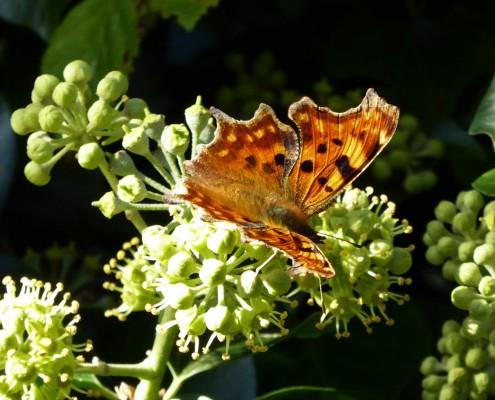Devon hedges were built and planted over 800 years ago to protect crops and livestock from the weather. Although a man made feature of the landscape their presence has also provided centuries of wildlife rich habitat for plants and flowers, mammals and pollinators.
In a recent Devon Hedgerow survey the secrets of these vital ecosystems were revealed – incredibly nearly over 2,000 different wildlife species live in just 900 meters of hedgerow! Put that together with the 33,000 miles of hedged landscape in Devon – well, I’ll leave the maths to someone else!
Devon hedgerows are still highly valued and enjoyed both by local residents and visitors, especially when the dazzling displays of wildflowers are in bloom, all fitting together in a perfect jigsaw of colours and shapes. Between April and July you’re likely to see primroses, bluebells, hedge parsley, wild garlic, greater stitchwort and many other plants, and they go on for literally mile after spectacular mile!
We should be glad that our ancestors built hedges to last: planted on earth banks called a Devon hedgebank, high and deep to protect crops and livestock from the the prevailing South Westerly winds. But they are not just a line of trees and shrubs, it’s more than that – a good hedge should have both flower rich and tussocky grass margin, and preferably a ditch as well, make up a wonderful wildlife habitat we see.
In more recent times our hedges came under threat when the Government advised farmers to destroy them to make way for large agricultural machinery and more intensive farming practices. Where those hedges disappeared so did the wildlife, so did the soil as it was eroded by the weather, so did the aesthetics of the landscape.
A Devon hedgerow wouldn’t be the same without the sturdy blackthorn which grows easily and spreads readily making the hedges thick, dense and dark, just a perfect bolt hole for wildlife. In May the Blackthorn makes a seasonal statement with a fine display of white blossom which fills the air with almond scent. Then gorse, holly and hazel squeeze into the gaps, and bramble, honeysuckle and dog rose fill in the margins. Deep down in the small holes pockets of soil create a root-hold for what becomes a myriad of wildflowers, grasses and ferns, in turn creating a nectar rich margin loved by insects, bees and butterflies.
Every few hundred meters along the hedge line a fully grown hazel or ash tree, itself supporting a whole ecosystem, will offer an excellent vantage point for a buzzard or tawny owl, or a temporary hang-out for bats. The hedgehog and hazel dormouse, both numbers in decline due to habitat loss, will use hedgerows to safely disburse after hibernation and to find a mate. Voles, shrews, weasels and stoats will stay undercover of a hedge, making a dash across the road to the other side only when necessary! Or a sparrowhawk will fly with great speed and agility along the edges, hoping to flush out and ambush small birds.
We have around 3 miles of hedges here at Dittiscombe and they provide vital habitats for our song birds: nest-building materials such as mosses, twigs and leaves; a food larder of insects during chick-rearing season; berries in the colder moths; and an all-important protection from predators.
We enjoy watching busy bird-parents flitting in and out of dark, cool, thick hedges to their eggs and newly hatched chicks. And when we trim or lay our hedges we find the empty nests of wrens, robins, goldfinches or spotted flycatchers, showing a map of all the new bird life that has been added to the natural world during the season!
Fortunately there is renewed efforts by local councils, landowners and farmers to not only protect Devon hedges, but to plant more with the help of charities such as Devon Hedges and the Devon Wildlife Trust. We hope that many future generations to come will to continue to protect, enjoy and celebrate our ancient and vital Devon Hedgerows.
 Previous guests to Dittiscombe Estate & Cottages find that the wildflower season is a magical time to visit us. Discover for yourself the secret world of an ancient South Devon hedgerow by taking a green lane walk, or cycle ride, along the lanes from Dittiscombe to the historic village of Slapton. If you’d like to stay in one of our old farm cottages on the estate, please visit our booking pages here.
Previous guests to Dittiscombe Estate & Cottages find that the wildflower season is a magical time to visit us. Discover for yourself the secret world of an ancient South Devon hedgerow by taking a green lane walk, or cycle ride, along the lanes from Dittiscombe to the historic village of Slapton. If you’d like to stay in one of our old farm cottages on the estate, please visit our booking pages here.
You can read more blogs about our local wildlife, driving in Devon lanes, and the history of Slapton and the Start Bay area on our Dittiscombe Blog Page.





















